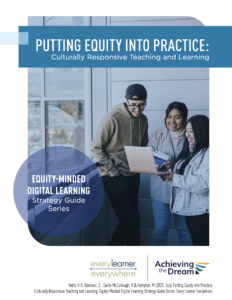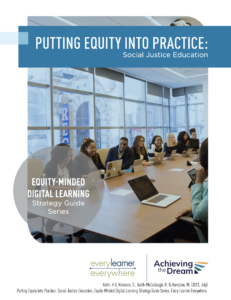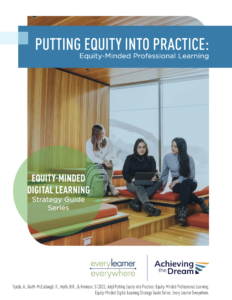Achieving the Dream, in collaboration with Every Learner Everywhere, has created a new series of digital learning strategy guides. Equity-Minded Digital Learning Strategy Guides is designed to support faculty as they engage with equity-minded pedagogies that advance the use of digital tools and professional learning approaches that affirm, uplift, and liberate students.
By empowering faculty to foster more inclusive, equitable, culturally responsive, and student-centered learning spaces, the guides hold the potential to transform the educational experience for both students and instructors.
The series of guides focuses on four pedagogical approaches: culturally responsive teaching, social justice education, open pedagogy, and equity-centered professional learning. Designed to facilitate active engagement for educators as they interact with the concepts presented, each of the four guides includes instructional strategies, practical implementation tips, and helpful digital tools that support instruction while providing flexibility in how to implement teaching and learning strategies.
The interactive design allows educators to engage with the guides in multiple modalities. Through resources pop-out links, videos, “how-to’s,” and exemplars, educators can utilize the guide in a variety of ways to advance their learning.
Culturally Responsive Teaching and Learning
The first guide of the series, “Putting Equity Into Practice: Culturally Responsive Teaching and Learning,” explores a pedagogy that serves as the umbrella framework to support educators as they utilize all the teaching and learning strategies discussed in the guides.
Culturally responsive teaching and learning, according to one of the guides’ authors H. Ray Keith, ATD’s associate director of teaching and learning, “centers the cultures, lived experiences, and perspectives of Black, Latinx, and Indigenous students in course content, curriculum, and instructional practices.”
By mitigating the potential racialized experiences of students from communities of color and marginalized identities, culturally affirming teaching encourages self-knowledge and racial identity development of students while acknowledging the societal contributions of racialized and marginalized groups.
The guide notes that culturally responsive pedagogy in higher education is not only growing more important as student demographics have diversified, but research has shown that this approach is academically beneficial to students as well.
The guide suggests three main strategies for creating a culturally responsive classroom: assessing and activating students’ prior cultural knowledge and recognizing it as an asset to fuel meaningful learning; empowering students by using referents from students’ own cultures to engage more deeply in their learning experiences while simultaneously affirming their community’s cultural wealth; and fostering classrooms that validate students’ distinct racial identities and experiences.
Sarah Kinnison, ATD’s associate director of program development and another of the guides’ authors, explains that culturally responsive teaching is about creating classroom experiences that affirm minoritized students. “Instructors can leverage cultural values, traditions, language, communication, learning styles, and relationship norms to create learning experiences that are meaningful to students with racialized identities,” she says.
Social justice education
The second guide, “Putting Equity Into Practice: Social Justice Education,” discusses how to foster students’ critical consciousness and capacity to analyze systems, policies, and practices that result in unjust and inequitable outcomes.
Social justice in higher education produces liberating learning spaces for students who have been marginalized because of their race/ethnicity, gender identity, religion, or differing abilities. The guide explores antiracist teaching and abolitionist teaching as two strategies for advancing social justice in the classroom.
Keith explains that antiracist teaching “disrupts practices that lead to racialized experiences of BILPOC students in learning environments,” gives voice to those students who have been traditionally silenced, and ensures equitable experiences and outcomes. Abolitionist teaching goes beyond reforming existing structures. It requires addressing racism and dismantling oppressive systems inherent in education, calling for a radical transformation of education towards liberation and justice. “Abolitionist teaching creates learning environments where BILPOC students thrive rather than survive,” he states.
The guide recommends ways of developing course content and curriculum grounded in antiracist and abolitionist strategies along with suggestions for digital tools that advance learning.
Open Pedagogy
“Putting Equity Into Practice: Open Pedagogy” describes an approach to teaching that encourages students to be creators of information rather than just consumers of it. Open pedagogy views learning as a participatory process, rather than one in which course material is broadcast from faculty to student and then repeated back by students via assignments and assessments.
Student-centered and flexible by nature, open pedagogy calls for students to interact with course content, faculty, outside experts, and classmates; to relate what they learn in the classroom to their own lives; and to view course material within a wider social context. This teaching methodology invites cultural responsiveness because learners are able to bring their cultural and lived experiences into the context of the course.
The guide supports faculty in operationalizing open pedagogy through a culturally responsive lens by focusing on four key strategies: renewable assignments that make real-world connections to the curriculum, coursework that is highly adaptable according to students’ interests (and, therefore, holds potential to be personally meaningful), co-created and student-generated content, and open assessment, which enables students to assess their own work or that of classmates in a transparent, collaborative manner.
The guide also touts open educational resources (OER), learning material that is freely and publicly available, as a flexible and accessible way to provide relevant materials and engaging assignments — and one that is highly compatible with culturally responsive practices.
“ The adaptability of open educational resources allows equity-minded instruction that centers the voices of BILPOC students, leverages students’ cultural wealth in various aspects of the course, and provides culturally responsive contexts that validate Black, Latinx, Indigenous, and first-generation students,” says Kinnison.
Equity-centered professional learning
“Putting Equity Into Practice: Equity-Minded Professional Learning” calls for professional learning to nurture a sense of belonging, prioritize equity, harness the strengths of faculty participants, and actively aim to develop and maintain cultural knowledge and practices that create an inclusive environment for professional learning participants.
According to the guide, effective and equity-minded professional learning facilitators must recognize their roles and positionality by identifying their own degrees of privilege. They must also understand how to elevate the voice of professional learners that tend to be silenced by traditional facilitation practices, getting to know them in ways that are meaningful to them; acknowledging their cultures, identities, and lived experiences; and inviting their feedback. Equity minded professional learning fosters belonging among learners through community building while being intentional about addressing behaviors that impede genuine professional learning.
Keith explains that the benefits of equity-centered professional learning for instructors translate to gains for students too. “[It] is about modeling and scaffolding promising practices that can be utilized by educators for their own learning and, in turn, can be applied to their teaching practices,” he states. “When faculty are equipped to effectively implement instructional practices that are inclusive, students’ engagement and learning experience can be transformed.”
As higher education continues to address the elimination of inequitable outcomes in teaching and learning for Black, Latinx, Indigenous, poverty-impacted, and first-generation college students, the Equity-Minded Digital Learning Strategy Guides series addresses a need in higher education and will serve as an important tool to support institutions in embedding equity, culturally responsive teaching, social justice education, and open pedagogy in teaching and learning.
Learn more about the Equity-Minded Digital Learning Strategy Guides
Learn more about ATD’s expertise in teaching and learning




